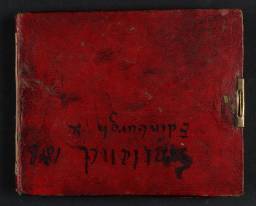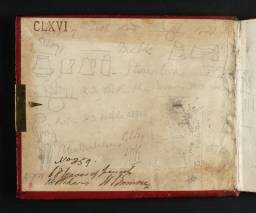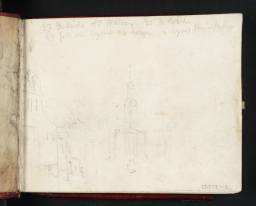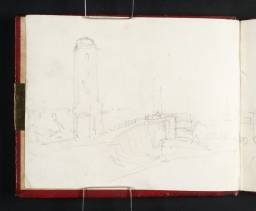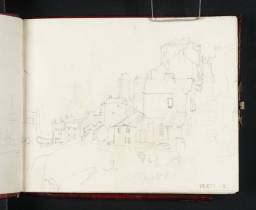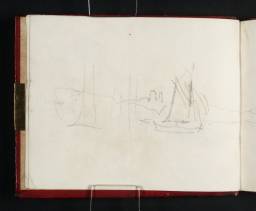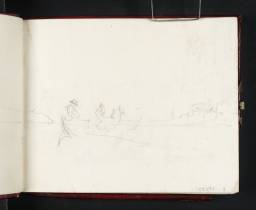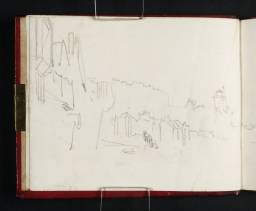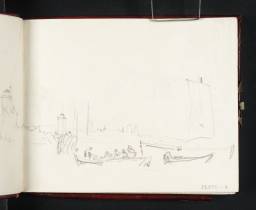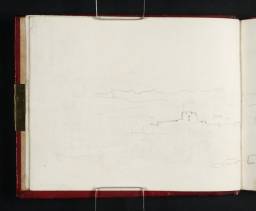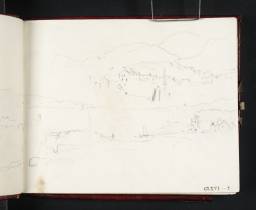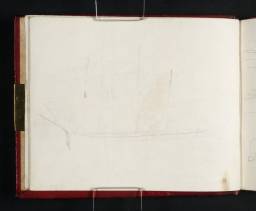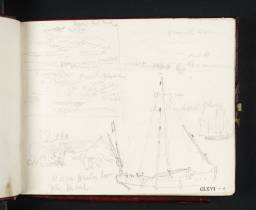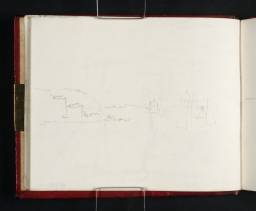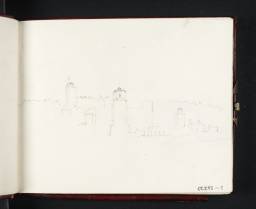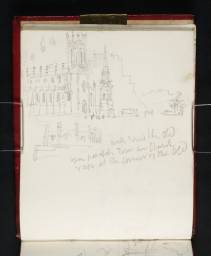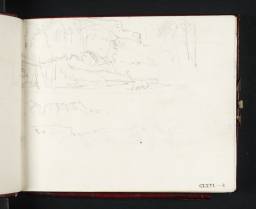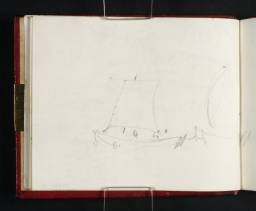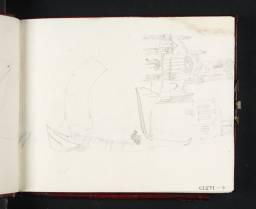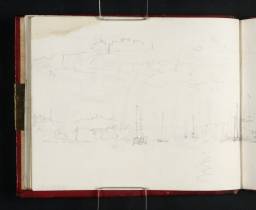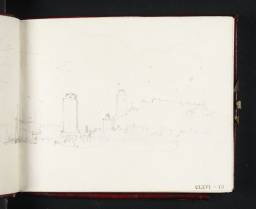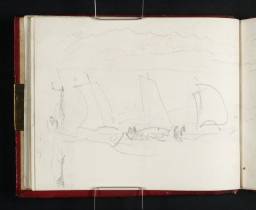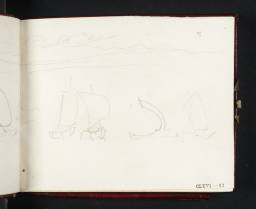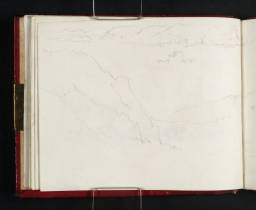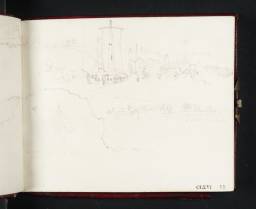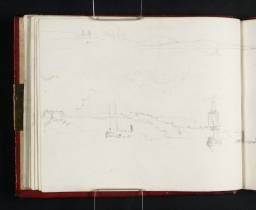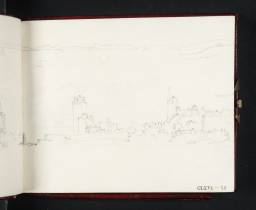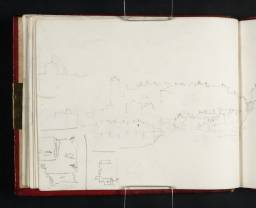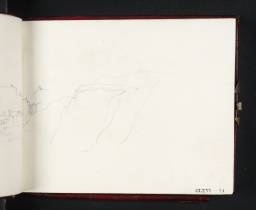Turner Bequest CLXVI
Red leather-bound pocketbook with patterned indented border, one broken brass clasp and pencil pocket at lower edge
70 leaves of white wove writing paper made on a double-faced mould by John Green at Hayle Mill, Maidstone, Kent. Watermarked ‘J GREEN | 1817’ on folios 14–21, 37, 40–43 (Tate D13475– D13489, D13521, D13527–D13533; Turner Bequest CLXV 14–21, 37, 40–43)
Approximate paper size 90 x 112 mm
70 leaves of white wove writing paper made on a double-faced mould by John Green at Hayle Mill, Maidstone, Kent. Watermarked ‘J GREEN | 1817’ on folios 14–21, 37, 40–43 (Tate D13475– D13489, D13521, D13527–D13533; Turner Bequest CLXV 14–21, 37, 40–43)
Approximate paper size 90 x 112 mm
Accepted by the nation as part of the Turner Bequest 1856
Exhibition history
References
Despite its title, which derives from Turner’s inscription on the front cover, this sketchbook in fact contains relatively few depictions of ‘Edinburgh’. A more accurate title is supplied by the spine label which was probably added by the artist in retrospect sometime after the trip: ‘92 Scotland Lothian’.
Most of the subjects depicted were sketched in connection to Scott’s Provincial Antiquities, the topographical publishing project for which Turner had come to Scotland to collect material. Six of the ten subjects that Turner was commissioned to paint for engraving are included in this sketchbook: Crichton Castle, Borthwick Castle, Roslin Castle, Dunbar, Tantallon Castle, and Linlithgow Palace.1 There are also three Provincial Antiquities subjects that he did not illustrate: Leith, Dalkeith and Edinburgh from Braid Hills; and three that were proposed but never illustrated: Hopetoun House, South Queensferry and Blackness Castle. Other views are generally close by and presumably sketched opportunistically on the way to visit proposed subjects: Rosyth Castle near North Queensferry, Port Edgar between South Queensferry and Hopetoun House, and Lauriston Castle near Edinburgh. Views of Edinburgh contributed to the artist’s image store, helping him to paint works such as Edinburgh from Calton Hill, circa 1819 (watercolour, National Gallery of Scotland),2 and subsequent Edinburgh subjects.
The Firth of Forth features throughout the sketchbook, sometimes within a sketch of a nearby Provincial Antiquities subject (Dunbar, Tantallon, Leith, Hopetoun, Queensferry and Blackness), but often as the subject in its own right. Turner covered the southern half of the estuary around Dunbar and North Berwick (see Bass Rock and Edinburgh sketchbook; Tate D13322–D13448; D40682–D40684; Turner Bequest CLXV), and walked the southern banks between Leith and Blackness, making panoramic sketches along the river as he went. Many of these are identifiable by notable places and features (such as the island of Inchgarvie), or can be identified from Turner’s accurate depiction of the terrain.
A series of sketches at the beginning of this sketchbook, however, do not relate to Scott’s Provincial Antiquities, but may have connections to another printing project, The Rivers of England series. These are sketches of North and South Shields near the mouth of the River Tyne. Turner visited North Shields after stopping at Newcastle to make a sketch in the Scotch Antiquities sketchbook (Tate D13588; Turner Bequest CLXVII 2) from which he painted Newcastle-on-Tyne, circa 1823 (Tate D18144; Turner Bequest CCVIII K),3 for the Rivers series. From Shields it would have been possible for him to carry on to Scotland by boat, but his itinerary, noted in this sketchbook, shows that he went via Morpeth, so he must have continued by coach (Tate D40916 and D13586; Turner Bequest CLXVII Inside Back Cover and CLXVI 70a).
The Edinburgh, 1818 sketchbook is one of three that Turner used during his tour of Scotland in 1818. Like the Bass Rock and Edinburgh sketchbook it was used to make many rapid sketches to record topographical, architectural and other visual information for reference, rather than to make detailed drawings as the basis of future paintings, as with the Scotch Antiquities sketchbook. The exception is Dunbar which was based upon a double-page sketch in this book (folios 24 verso–25; D13496–D13497) as well as two drawings in the Scotch Antiquities sketchbook (Tate D13633–D13634, D13639–D13640; Turner Bequest CLXVII 29a–30, 31c–32). In general, however, subjects were drawn repeatedly from near and faraway and from different vantage points (such as an unidentified harbour and Linlithgow Palace), although the book is used less systematically than Scotch Antiquities which has several sequences recording a subject from every direction as Turner made a circuit around it. Rather it seems to have been employed in a more ad hoc manner, coming to hand when the artist wanted to make a quick note. The scattered order of the subjects in the sketchbook therefore seems to be a result of its use at the time, as the leaves appear to have remained bound in their original order.
The sketches are highly economical, although generally more carefully drawn than the slightest of the Bass Rock and Edinburgh sketches, and are often restricted to outlines with visual or written notes to record details, and while subjects are often drawn several times, details that are sufficiently recorded once are rarely repeated unless new information is added. Shading, hatching and other techniques are eschewed unless they help to define the bare facts of a subject such as its size and shape.
Crichton Castle, circa 1818 (watercolour, The Morgan Library & Museum, New York); Borthwick Castle, 1818 (watercolour, Indianapolis Museum of Art); Roslin Castle, circa 1820 (watercolour, Indianapolis Museum of Art); Dunbar, circa 1823 (watercolour, private collection); Tantallon Castle, 1821 (watercolour, Manchester City Art Galleries); Linlithgow Palace, 1821 (watercolour, Manchester City Galleries); Andrew Wilton, J.M.W. Turner: His Life and Work, Fribourg 1979, pp.425 no.1059, 426 nos.1060, 1065, 1066, 1067, 1068.
How to cite
Thomas Ardill, ‘Edinburgh 1818 sketchbook 1818’, sketchbook, April 2008, in David Blayney Brown (ed.), J.M.W. Turner: Sketchbooks, Drawings and Watercolours, Tate Research Publication, December 2012, https://www

